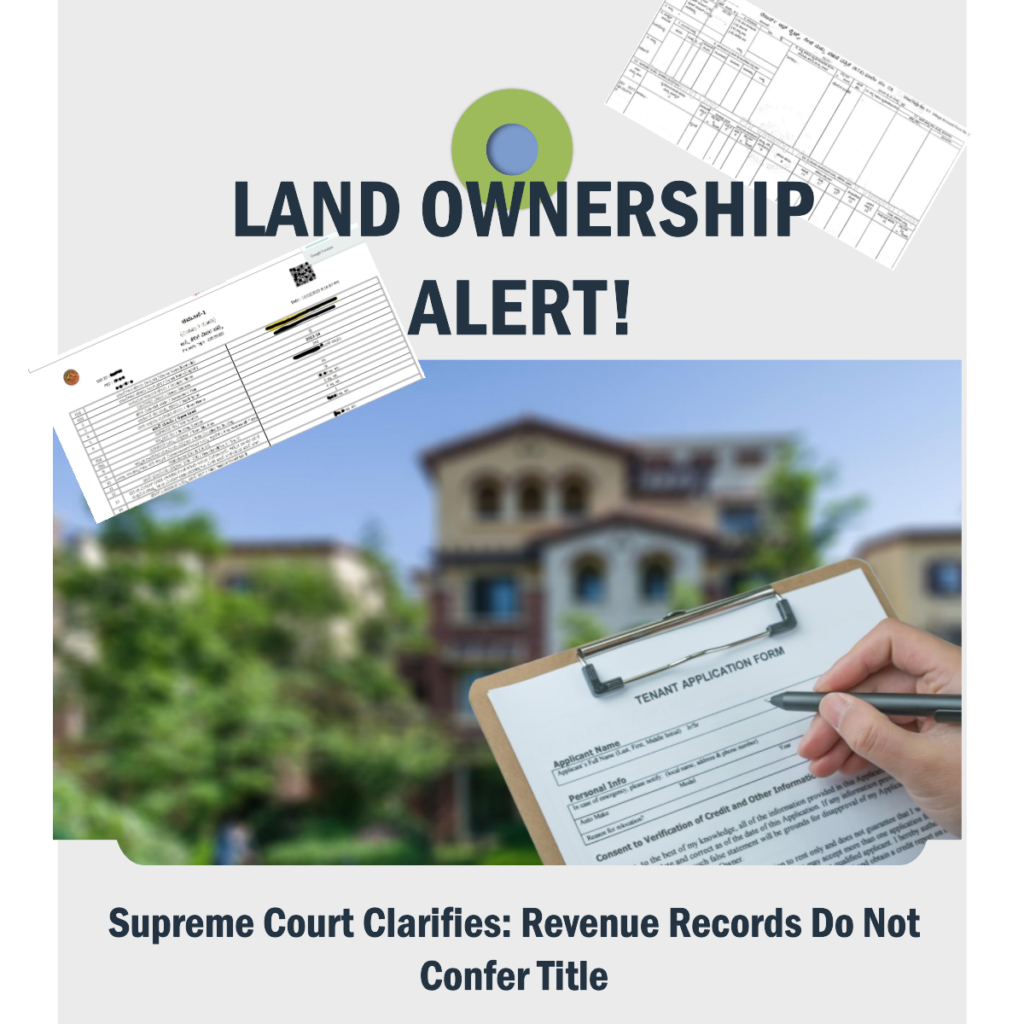Revenue Records: In a groundbreaking judgment, the Supreme Court emphatically reiterated a crucial legal principle: revenue records, in and of themselves, do not serve as documents of title. The Court, in the case of P. Kishore Kumar vs. Vittal K. Patkar, decisively held that the mere mutation of revenue records does not divest the true title-owners of their right, title, and interest in the land.

P. Kishore Kumar Vs. Vittal K. Patkar
The Appeal
This civil appeal challenges the judgment and decree issued on November 29, 2010, by the Karnataka High Court. The High Court’s decision, acting under Section 100 of the Code of Civil Procedure, 1908 (“CPC” for short), allowed an appeal and reinstated the decree of the Trial Court. This, in turn, reversed the first appellate court’s decision that had dismissed the plaintiff’s suit. In simple terms, the High Court’s judgment brought the Trial Court’s original verdict back into effect.
BRIEF RESUME OF FACTS
i)The factual matrix of the case, insofar as is relevant for the purpose of a decision on this appeal, is set out hereinbelow:
ii)The pleaded case in the plaint is that land comprised in Sy. No. 3, measuring 187 acres 38 guntas, in Navarathna Agrahara, Hobli, Devanhalli Taluk, Bangalore, devolved upon the plaintiff’s predecessorin-interest, K. Muniyappa @ K. Shamaiah vide a Family Settlement Deed dated 30th July, 1953. ii) 15 acres out of the said land was sold by K. Shamaiah to the vendor of the plaintiff, i.e., Smt. Akula Yogamba (“plaintiff’s vendor” hereafter)
vide registered sale deed dated 14th February, 1958.
iii) The Mysore (Personal & Miscellaneous) Inam Abolition Act, 1954 (“the Act” hereafter), enacted for abolition of Inams in the State of Mysore, came into force on 15th March, 1955. By virtue of the Act, all rights, title and interests in the land, hitherto vested in the Inamdars, ceased and came to be vested absolutely in the State of Mysore. However, the Act provided for an opportunity to the Inamdars to make an application
under section 9 thereof to register as an occupant of the land.
iv) The plaintiff’s vendor applied under section 9A of the Act and sought occupancy rights in respect of 15 acres of Sy. No. 3. According to the plaintiff, the claim of the plaintiff’s vendor succeeded before the Special Deputy Commissioner of Inams (“Commissioner”, hereafter). The Commissioner passed an order dated 25th November, 1958 (“Commissioner’s order”, hereafter) while deciding this application, which reads as follows:
Order sheet
In the Order of Special Case No. 51/1958-59
| Sl. No. | Order of proceedings with signature of Presiding Officer | Signature of parties or pleaders when necessary |
| The persons noted below have purchased the lands noted against them after the date of vesting from jodidars | ||
| 1 | Sri. Keralavarma S.No. 13_33-00 | |
| 2 | Sri. Lokaranjan, S. No. 13_20-00 | |
| 3 | Smt. Akula Yogama S. No. 3_15_00 | |
| 4 | Sri Venkata Rao S.No. 3_1-4 | |
| 5 | Sri M. Raja Rao S. No. _ Dry 3-26, 6- 00 | |
| 6 | S. No. 3 ____ 12-00 | |
| 7 | Hence, the claim of the applicants may be rejected and Khata u/s 9 of the Act in the name of the jodidar may be made.Sd/- Special Deputy Commissioner for Abolition of Inams Kolar District, Kolar | |
| 25th November, 1958 Order |
Order
The claimants were not tenants at the time of vesting. Therefore, claims of Sri Keralvarma, Yogamba, Bheemavarapu Venkata Rau, Sri Ranga Rao are ordered to be rejected. These numbers are separately registered in favour of the Inamdars under Section 9. 13/33, 13/20 are registered in favour of the Inamdar Sri K. Srinivasamurthy u/s 9 and 3/15, 3/1-2, 2/3-36, 16/2-6, 3/12 are ordered to be registered as occupant. Dictated, transcript edited by me and then pronounced in open court.
Special Deputy Commissioner
for Abolition of Inams, Bangalore
It is the interpretation of the Commissioner’s order which forms the fulcrum of the present dispute.
v) While the plaintiff alleged that the claim of the plaintiff’s vendor was accepted, thus making the plaintiff the lawful owner with the better title, the appellant – defendant (“defendant” hereafter) in his written statement alleged that the Commissioner’s order granted occupancy rights under section 9 in favour of his predecessor-in-interest, i.e., K. Srinivasa Murty, the Inamdar, from whom the defendant purchased 5 acres and 28 guntas, thus vesting him with the better title.
vi) Amendments made to the Act in 1979 vested the powers of the Special Deputy Commissioner with the Land Tribunal. Upon applications being made by other tenants for occupancy rights in Sy. No. 3, the Land Tribunal, vide order dated 20th September, 1982, conferred occupancy rights on the defendant’s predecessor-in-interest, with respect to an extent of 21 acres in Sy. No. 3. An endorsement to the same effect was also led in evidence by the defendant.
vii) Sale deeds were thereafter executed for the same parcel of land by both sides. While the plaintiff’s vendor sold an extent of 15 acres to the plaintiff vide registered sale deed dated 12th November, 1987, the defendant purchased 5 acres and 28 guntas comprised in Sy. No.3 vide registered sale deeds dated 20th June, 1984 from his respective
vendors.
viii) Portions of Sy. No.3 being sold to two different parties, a dispute between the two parties became imminent and, in fact, triggered O.S. 506/1995 (“the suit” hereafter) instituted by the plaintiff, inter alia, praying for declaration of title and permanent injunction
The decree passed by the Trial Court and Reason for arriving at such a conclusion
The learned Civil Judge (“Trial Court”, hereafter) after extensive examination of revenue records adduced by the plaintiff, and the Commissioner’s order, held that the ownership of the suit property vested in the plaintiff’s vendor. In arriving at such a conclusion, the court was predominantly persuaded by Ext. P8 (Record of Rights), which recorded that vide order dated 24th March 1959 passed by the Special Deputy Commissioner, Inam Abolition, occupancy rights had been conferred on the plaintiff’s vendor. However, no order or endorsement of the said date was actually exhibited before the Trial Court. The decree passed by the Trial Court is quoted below for facility of understanding:
“After contest, it is ordered and decreed that the suit of the plaintiff is hereby decreed. It is declared that the plaintiff is the absolute owner of the B Schedule property and the defendant or any persons claiming through him are hereby permanently restrained from interfering with the peaceful possession and enjoyment of the plaintiff over the suit schedule A and B properties.”
Regular Appeal
Aggrieved by the decree, the defendant carried it in an appeal under section 96 of the CPC before the learned District Judge. The firstappellate court overturned the findings of the Trial Court, on the premise that revenue records alone could not aid the plaintiff in establishing his title, especially in the glaring absence of any Inam grant in favour of the plaintiff’s vendor. It was noted by the appellate court that though the plaintiff referred to the order dated 24th March, 1959, the same was not led in evidence.
xi) A second appeal carried by the plaintiff before the High Court succeeded vide the judgment and order impugned herein. The High Court framed the following question of law for decision which, according to it, was a substantial question of law:
“Whether the lower appellate court had erred in law in not considering Ex P-1 to Ex P-29 and the admissions made by defendant (DW-1)?”
The High Court interpreted the Commissioner’s order to be in favour of the plaintiff’s vendor, such interpretation being bolstered solely by the revenue records exhibited by the plaintiff. Though it was noted that the grant of occupancy rights in favour of the plaintiff’s vendor under section 9A was contrary to the provisions of the Act, it was observed that the decision having attained finality could not be challenged after such extensive passage of time before a civil court. The plaintiff was, Therefore, held to have established the better title, resulting in
upholding of the decree passed by the Trial Court.
Civil Appeal
Defendant Argument
Learned senior counsel for the defendant, Mr. A Diwakara. Highlighted the dissatisfaction recorded by the High Court with the evidence adduced by the plaintiff, & stressed that in view of the same, the Court could not have held the plaintiff to establish a better title than the defendant, more so when the Court itself recorded the fact that the grant of occupancy rights in favour of the plaintiff’s vendor under section 9A of the Act was contrary to its import.
It was argued by him that the plaintiff’s vendor being a purchaser, could not have applied as an “occupant” under the provisions of the Act. Such application being restricted only to tenants. The Commissioner’s order categorically recorded that the plaintiff’s vendor was not a tenant at the time of vesting of the land; therefore, the order could not, by any stretch of imagination, be interpreted to vest occupancy rights in the plaintiff’s vendor.
Plaintiff Argument
Per contra, Mr. S.N. Bhat, learned senior counsel for the plaintiff, argued that the plaintiff’s vendor had made an application for occupancy rights in 15 acres of Sy No. 3, and the Commissioner, while noting that the vendor was not a tenant at the time of vesting, went on to record that occupancy registration under section 9A be done. He strenuously advanced the record of rights for the year 1983 in the name of the plaintiff’s vendor, along with subsequent revenue entries in the name of the plaintiff, to argue that it was the plaintiff, and his vendor before him, who were being treated as the rightful owners by the revenue authorities, such authorities having rightly interpreted the Commissioner’s order to mean that ownership vested in the plaintiff’s vendor.
Judgment and Decree
The impugned judgment and decree are, accordingly, set aside. The civil appeal stands allowed and the decree passed by the Trial Court, extracted hereinabove, is set aside with the result that the plaintiff’s suit shall stand dismissed. There shall be no order as to costs
Factual Background: Unraveling the Land Puzzle
The crux of the matter revolved around a Family Settlement Deed from 1953, which conveyed ownership to K. Muniyappa. Subsequent transactions, including a sale to Smt. Akula Yogamba in 1958, laid the foundation for the dispute. The 1954 Inam Abolition Act further complicated matters.
Commissioner’s Order: Deciphering the Key Revenue Records
The linchpin of the dispute was the Commissioner’s order from 1958, a critical juncture in determining ownership. The plaintiff asserted that the order favored them, granting occupancy rights. However, a meticulous examination revealed a different narrative – the rejection of the plaintiff’s vendor’s claim.
Role of Revenue Records: A Fiscal Mirage
While the plaintiff relied heavily on revenue records to establish ownership, legal precedent underscores their limited probative value. The Court emphasized that these records, mere fiscal tools, don’t confer or extinguish title. A clear distinction drawn between legal documents and fiscal entries.
Burden of Proof: A Critical Examination
he Court, firmly aligning itself with established legal principles, underscored the plaintiff’s unwavering responsibility to establish a compelling case for a declaration of title. A meticulous review of the plaintiff’s case revealed critical deficiencies, particularly the glaring absence of documents to substantiate their claim. This lack of evidence ultimately proved decisive in the Court’s decision.
Deficiency in Vendor’s Title: A Critical Oversight
The sale deed executed by the plaintiff’s vendor came under scrutiny, revealing a critical omission. It failed to disclose the vendor’s unsuccessful attempt to secure occupancy rights. The principle of “nemo dat quod non habet echoed” – ‘no one can give what they do not have’. Means “The purchase of a possession from someone who has no ownership right to it also denies the purchaser any ownership title.
Verdict: High Court’s Reversal Critiqued
However, the High Court’s intervention, deemed unwarranted, disrupted the first appellate court’s findings. When harmoniously interpreted alongside legal principles, the Commissioner’s order ultimately favored the defendant’s claim. As such, the High Court‘s approach, found untenable, contradicted established legal precedents.
Conclusion: Revenue Records, A Clear Ruling, A Resolved Dispute
In a decisive verdict, the Supreme Court definitively settled the dispute, resoundingly siding with the defendant & consequently overturning the Trial Court’s decree. This landmark judgment furthermore underscores the crucial role of meticulous legal work and impeccably robust documentation in land ownership disputes. By providing clarity and finally bringing closure to a protracted legal battle. This decision subsequently serves as a valuable precedent for future cases.



Leave a Reply